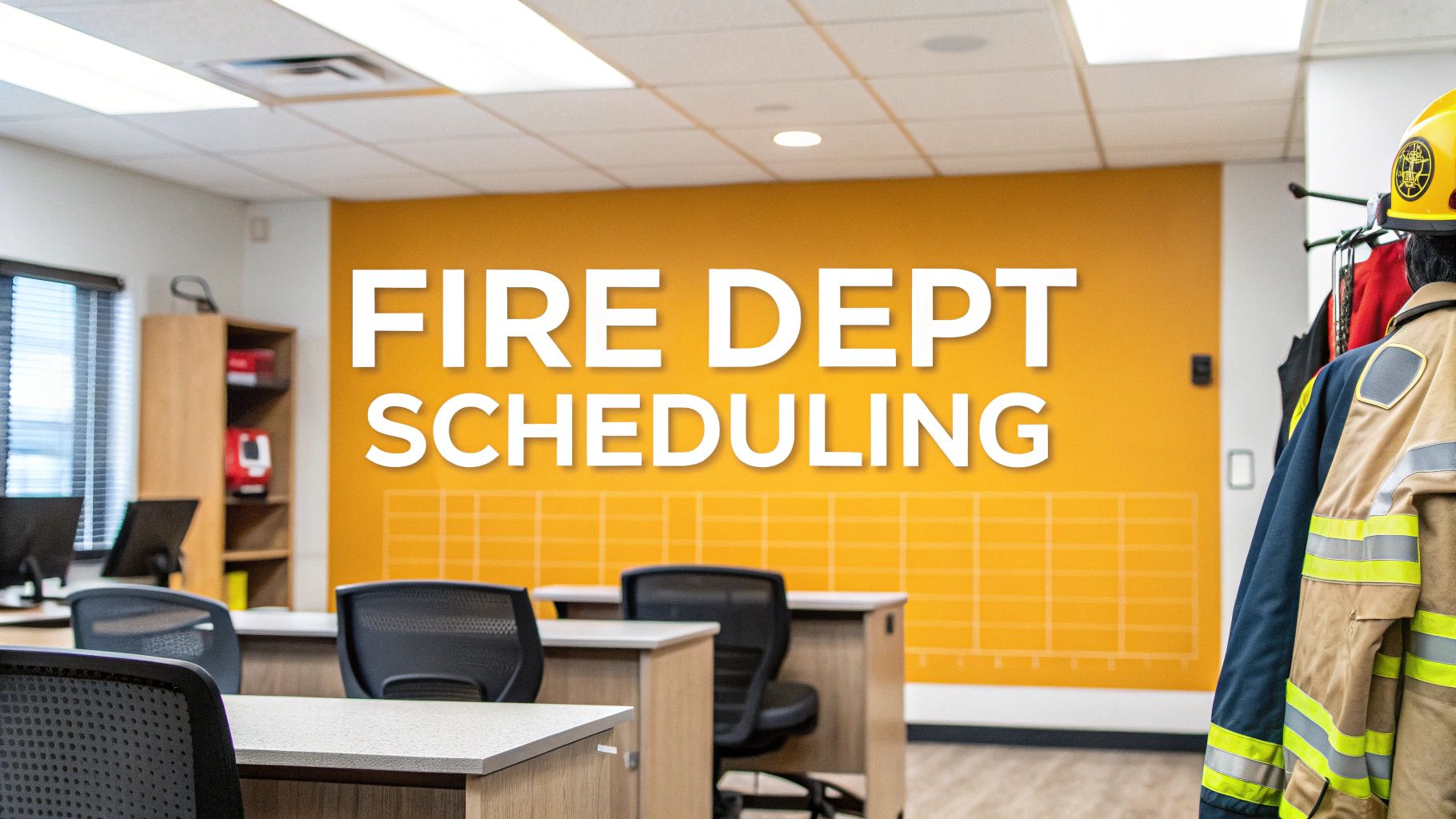From our resource library for organizational scheduling and management.
The Ultimate Guide to Fire Department Scheduling: Transform Your Department's Efficiency and Safety

The Evolution of Modern Fire Department Scheduling
Managing schedules for fire departments goes well beyond simply filling shifts on a calendar. Fire departments must balance emergency response capabilities, personnel wellness, ongoing training needs, and limited budgets. Many departments previously used basic, rigid schedules that often resulted in overworked staff and wasted resources. This approach has shifted as fire services recognize the need for flexible, strategic scheduling.
Traditional Scheduling Models and Their Limitations
The 24-hour shift has been the standard schedule for decades, with 75% of U.S. fire departments following a 24-hours-on, 48-hours-off pattern. While this model can reduce staffing needs by 15%, questions remain about its effects on firefighter health and job performance. Studies show increased sick leave usage and decreased alertness during extended shifts. Learn more about shift impacts from USFA
The basic scheduling models also struggle to support modern firefighting roles. Today's firefighters need expertise in hazardous materials response, specialized rescue operations, and emergency medical care. Fixed schedules make it hard to maintain the right mix of skills and certifications across all shifts. This has motivated departments to look for better scheduling solutions.
The Rise of Data-Driven Scheduling
Forward-thinking departments now use data analysis to create smarter schedules. By studying emergency call patterns, response times, and staff availability, they can optimize shift coverage. For instance, departments can add more personnel during historically busy periods identified through call volume data.
This analytical approach also helps prevent firefighter fatigue. Departments track factors like work hours and rest periods to develop schedules that reduce tiredness and potential mistakes. The data-driven method creates more transparent and equitable shift assignments, which improves staff morale.
Embracing Technology for Enhanced Scheduling
Modern fire department scheduling software has transformed how departments manage their personnel. These tools automate time-consuming tasks like tracking certifications, managing overtime hours, and following union agreements. This frees up scheduling managers to focus on strategic planning and optimization. The technology enables fire departments to be more efficient and responsive while taking better care of their firefighters.
Breaking Ground with New Shift Patterns

Fire departments across the country are testing new ways to structure their work schedules. The goal is simple - find patterns that work better for both firefighters and the communities they serve. Many departments are taking a fresh look at their current schedules and trying out different approaches.
The 48/96 Schedule: A Popular Choice
The 48/96 schedule has gained significant traction among fire departments. Under this system, firefighters work for 48 consecutive hours followed by 96 hours (4 days) off duty. The extended break gives crews more time to rest and recharge between shifts. Currently, 80+ departments have either switched to this schedule or are testing it out. For example, when the Pacifica Fire Department made the change, they saw sick leave drop by 20%. Want to learn more? Check out the Sacramento Feasibility Report.
Making Kelly Days Work
Kelly Days play a key role in modern fire department scheduling. These are extra days off that firefighters earn, typically through overtime work. They help create predictable breaks and improve work-life balance. Getting Kelly Days right takes careful planning to maintain proper staffing levels while meeting individual needs.
Finding What Fits
Each fire department needs a schedule that matches its specific situation. The right fit depends on many factors - the size of the community, how many calls they handle, and their budget. A rural department might need something completely different from a big city station. Looking for scheduling ideas? Here's a helpful guide: Fire Department Scheduling Software: The Ultimate Playbook for Modern Emergency Services.
Making Changes Successfully
Switching to a new schedule takes work and planning. Success comes from getting everyone involved - firefighters, union reps, and department leaders all need a voice in the process. Clear communication helps avoid confusion and keeps things running smoothly. Regular check-ins and adjustments ensure the new schedule continues to meet everyone's needs over time.
Maximizing Performance Through Strategic Scheduling

Smart scheduling makes a real difference in how well firefighters perform and feel. Getting the schedule right isn't just about filling time slots - it's about understanding how different work patterns affect both individuals and teams. Good scheduling takes into account sleep quality, stress levels, and recovery time between shifts.
The Science of Shift Work and Firefighter Well-being
Our bodies follow a natural circadian rhythm that controls when we sleep and wake. Fire department shift work often throws this rhythm off balance. When this happens, firefighters can experience sleep strain - they struggle to get enough quality rest, which affects how alert and effective they are on the job. Take the common 24/48 schedule - while it gives firefighters longer breaks, working for 24 straight hours can really wear them down.
Being tired is serious business for firefighters. It slows down their reactions, makes it harder to think clearly, and increases the chance of mistakes. These risks are especially concerning given the high-stakes nature of firefighting. Long-term sleep problems can lead to health issues like heart disease, diabetes, and mental health challenges. Different schedules like the 24/48 and 48/96 each have their own effects on firefighters' health and job performance. Research shows that about 30% of departments use the 24/48 schedule, while 23% work 24 hours on, 24 off. Each of these patterns can make it hard for firefighters to maintain normal sleep patterns and recover properly. For more details, check out this research: Impact of Shift Schedules on Firefighter Well-being
Optimizing Schedules for Peak Performance
Creating good fire department schedules means finding the right balance between getting the job done and keeping firefighters healthy. Here are some key ways to reduce the downsides of shift work:
- Rotation Length: More frequent rotation changes can help firefighters adjust better
- Shift Start Times: Starting shifts when they match natural sleep patterns improves rest quality
- Strategic Breaks: Regular breaks during shifts help fight tiredness and keep people alert
- Sleep Hygiene Education: Teaching firefighters about good sleep habits helps them manage their rest better
Monitoring and Intervention
Keeping track of how schedules affect firefighters is crucial. Departments should watch things like how much sleep people get, how tired they are, and any incidents that happen. When departments spot early signs of fatigue-related problems, they can step in to help. This might mean changing schedules, connecting firefighters with sleep experts, or offering programs to help manage stress. When departments put firefighter well-being first through smart scheduling, everyone benefits - including the communities they serve.
Leveraging Technology for Scheduling Excellence
Fire departments are improving their scheduling systems by combining smart software tools with experienced human oversight. This blend helps create schedules that work better for everyone while making daily operations run more smoothly.
Evaluating Scheduling Software Options
When choosing scheduling software for your fire department, certain features make a big difference. Mobile access lets staff check schedules and request time off from their phones. Smart callback systems help distribute overtime fairly and quickly. Good software should also include compliance tracking for certifications and union rules, connect smoothly with your existing systems, and offer clear reporting tools to track important metrics like staffing and overtime use.
Avoiding Costly Technology Mistakes
The wrong software choice can waste both time and money. Take time to find options that fit your department's size, budget, and technical needs. Think about how long implementation will take and what kind of support you'll get from the vendor. Getting everyone on board early makes the transition much easier. For more insights, check out our guide on How to master modern shift systems.
Building a Digital Scheduling Infrastructure
Good scheduling isn't just about the software - it's about creating a system that works with your current processes and can grow with your needs. Make sure to train your staff well and set up clear ways for people to ask questions and get help. This thorough approach helps create a schedule that works better for everyone.
Maximizing ROI on Scheduling Technology
Focus on features that solve your biggest problems. If overtime costs are high, look for strong overtime management tools. If you need to track special skills and certifications, prioritize those features. Match your technology choices to your specific needs. This practical approach helps departments save money while keeping the flexibility they need to respond to emergencies.
Implementing Schedule Changes That Actually Stick

Making changes to a fire department's schedule requires more than just selecting new time slots. Success depends on thorough preparation, active communication with staff, and methods to handle any issues that come up. Getting everyone on board - from chiefs to crew members - is essential for the changes to last.
Building Buy-In and Managing Resistance
Staff pushback often presents the biggest challenge when changing schedules. Many firefighters have valid concerns about how new schedules might affect their family time and established routines. The best approach is to address these worries directly through:
- Open discussion forums where crews can share thoughts and questions
- Early involvement of union representatives in the planning stages
- Test runs with volunteer teams before full rollout
- Gathering and using crew feedback to improve the schedule
Some departments have found that starting with a pilot program helps crews adjust gradually. This gives firefighters hands-on experience with the new system and allows time to work out any issues before department-wide implementation.
Transition Planning and Communication
A detailed transition plan helps minimize disruption when switching to a new schedule. The plan should include:
- Clear timeline with key dates and milestones
- Defined roles and responsibilities
- Regular progress updates
- Multiple communication channels
Getting information out effectively means using various methods like emails, in-person meetings, and department message boards. Quick responses to questions and concerns help maintain trust throughout the change process.
Measuring Impact and Making Adjustments
Once the new schedule starts, keeping track of results becomes critical. Department leaders should monitor:
- Overtime expenses
- Sick leave patterns
- Staff satisfaction levels
- Response times
- Coverage effectiveness
For more insights on managing staffing during transitions, see: Emergency Staffing Solutions: A Strategic Guide to Crisis Management and Operational Continuity
Different departments have different needs - what works in one station may not work in another. Being ready to make changes based on real-world results helps ensure the new schedule meets both department and firefighter needs. This focus on continual improvement leads to better efficiency, higher morale, and enhanced service to the community.
Preparing for the Next Generation of Fire Service Scheduling

Fire departments face ongoing changes that affect how they operate and schedule their teams. From shifting community needs to new types of emergency calls, departments must adapt their scheduling approaches to meet these challenges. Many departments are taking proactive steps to update their scheduling systems.
Adapting to Evolving Service Demands
Today's firefighters handle much more than just fires. They respond to medical emergencies, hazmat incidents, technical rescues, and more. This means departments need flexible schedules that place the right people with the right skills on duty at the right times. For instance, some departments now adjust staffing based on call patterns, scheduling extra paramedics during peak medical call hours. Training also needs careful scheduling to keep skills sharp without impacting emergency response capabilities.
Making the Most of New Scheduling Tools
Smart scheduling software helps departments manage complex shift patterns and track important certifications. New tools can analyze past call data to help predict future staffing needs. Some departments are testing systems that can quickly adjust schedules when unexpected situations arise, like multiple major incidents or sudden staff shortages. This helps maintain proper coverage while making life easier for scheduling managers.
Building Flexible Schedule Systems
The most successful departments create scheduling systems that can change and grow over time. Being adaptable means easily handling new types of calls, different shift patterns, or updated staffing requirements. Many departments now use modular scheduling approaches that let them quickly adjust crew sizes and skill mixes. Regular schedule reviews using real performance data and staff feedback help ensure the system keeps working well.
Keeping Service Quality High
While updating scheduling practices is important, departments must maintain their core mission of protecting their communities. Any scheduling changes need careful testing to ensure they won't slow response times or tire out crews. Smart departments regularly check how new schedules affect their performance by gathering input from firefighters and analyzing response data. This balanced approach helps departments improve while maintaining high safety standards.
Ready to update your department's scheduling system? Acroroster offers specialized scheduling tools built for modern fire departments.